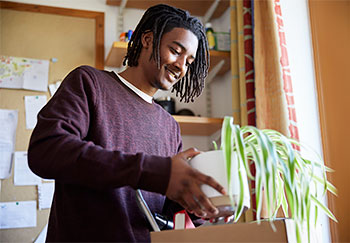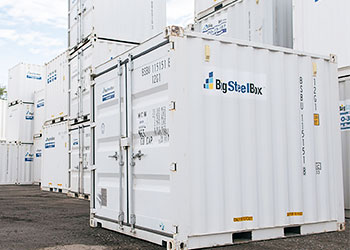
Parents watch child pack to leave for college
How To Help Your Child Make the Transition to College
The transition from high school to college or university is a big one for everyone involved: parents and children – well, they’re almost young adults, but to most parents they’ll be their babies no matter what age! Perhaps that fact is what makes the thought of a child moving away for school so emotionally tough and sentimental for parents. Where did the time go?!
But, it’s also a really positive and exhilarating time for both parties. Parents should be bursting with pride to watch their child leaving home for higher learning, and for the student, it’s the start of a very exciting new stage in their life.
All emotions aside, helping your child make the transition to college or university that includes moving to a new city or province also comes with a set of very practical tasks that need to be done as well. You’ll have to think things through and plan ahead to make sure the move goes as smoothly as possible.
Whether your child will be living in a dorm or apartment when they head off for their post-secondary education, there’s a lot to prepare in advance. Read on for some tips to help your child make the transition to college or university.
Getting Ready To Move
First we’ll say that while it may be tempting to take control of the move planning, it’s important to let your child take the lead on some or much of it. They’re transitioning into adulthood and they may find their newfound independence overwhelming if they haven’t had to take on important responsibilities in the past. So, while they’ll likely need your guidance and help throughout the process, try to encourage them to take ownership of as many aspects of the move as possible.
How you and your child decide to organize and plan their move to school away from home will depend on the distance they’re traveling and how they’ll get there. The main options are:
 Drive their own car
Drive their own car- Parent drives them by car (with or without a rented truck or trailer)
- Rent moving truck
- Fly
Once you’ve figured out the transportation and arranged travel, your next step should be breaking things down into these categories:
What to take with you.
The distance your child is moving for school and how they’ll get there will likely dictate how much they can take with them. If you’ll be able to drive them there in a vehicle or they’ll drive themselves in their own vehicle, you may have room to send things like towels, bedding, electronics, toiletries, and school supplies. Sending these types of items that you already own but are ok to part with is a good way to save money, but they will all take up space.
If your child is moving in with a roommate and they’re able to connect prior to the move, that’s a good way to make a plan around bigger items they can share, like a TV, mini fridge, speakers, dish ware and furniture. If you can each contribute to these types of items, that will cut down on the amount you need to take with you.
What to buy when you get there.
If your child is moving to a new city or province and flying makes more sense, then you’ll likely need to pack lighter, only sending the essentials and personal/sentimental items like clothing, shoes and small decorative items with them. The other necessities like toiletries, towels, bedding, etc., can be purchased when you get there. Again, connecting with a roommate in advance of moving day is a good idea.
What to ship.
If there are items they don’t have room to take because they’re going by plane, you could opt to ship them some things by Canada Post or courier after they’re settled. In this case, be sure to weigh the advantages of that versus buying things new in their new city, you may not end up saving a lot by shipping things to them.
Make a List
Every good plan has a list (or lists as we noted above). Once you know how your child will get there and what you’ll have room to take with you, you can start focusing on the details of the move. Here are some important categories that will require lists:
Clothing
Are you moving to a city with a different climate than you’re used to at home? If so, that may mean you need to get certain types of clothing you may not have, like winter boots and a heavier jacket if you’re moving somewhere colder like from Vancouver to Winnipeg. Or, if you’re moving from a colder climate to a place that has more temperate winters, you may be able to leave some of your heavier winter clothing behind.
Bedding
Whether you’re moving into a dorm or apartment, your child will likely want to find a way to bring some of their style into their new living quarters. An easy way to do this is to bring bedding and a comforter with a pop of colour or design that will brighten their new bedroom. If they’ll take bedding they already have, list what you need to pack or ship. If they’ll buy new when they get there, make a list of those items.
Toiletries
This may be something that can be purchased once your child is settled in their new space, but it’s important to sit down with them to list the things they should have, but may not think about. Things like shampoo, conditioner, toothpaste, soap, etc., are easy to remember. But, there may be items that Mom and Dad have supplied their whole lives that they may not think about, like bandages, antiseptic or medical ointment (like polysporin), and medication for things like a cough and cold, allergies, and stomach issues.
Cleaning Supplies
 This is another category of items that you’ve likely always supplied throughout your child’s life, but will now be their responsibility. Cleaning supplies like dish soap, laundry detergent, a vacuum, and antibacterial wipes are just a few of the items they should keep on hand (and use!) on a regular basis.
This is another category of items that you’ve likely always supplied throughout your child’s life, but will now be their responsibility. Cleaning supplies like dish soap, laundry detergent, a vacuum, and antibacterial wipes are just a few of the items they should keep on hand (and use!) on a regular basis.
There are plenty of other things you’ll need to add to your college moving list, so check out this Ultimate College School Supply List for more ideas.
Packing
The way you choose to pack your child’s items to send them off to college or university also depends on how far they’re going and how they’ll get there.
If you’ll be driving, consider the amount of space you have inside your vehicle for boxes, suitcases, electronics, etc. You may want to consider renting a small trailer if your vehicle is equipped to pull one. This would allow them to take more things with them, and even have room for larger items like a bicycle, or even their own mattress. Just remember that you’ll need to get those same items home at the end of the school year, or put them into storage between school years (more on this below).
If they’ll be flying to their post secondary school, then you’ll have to pare things down and opt to buy certain items when they arrive. As mentioned above, shipping things via Canada Post or courier may not be the most cost effective option.
If you have enough time before their move, encourage your child to declutter their room and purge some of their stuff – they could even make a little money by having a garage or yard sale before they leave. Heck, use the opportunity to get rid of some of your things too! Or, there’s always the option to donate items that are in good condition but no longer needed to a local charity or organization like Value Village.
For more packing tips check out these Top 10 Moving and Packing Tips or check out these moving and packing apps to help keep yourself organized and on track.
Move-in Day
Most colleges and universities have a move-in schedule for students. Be sure to research this in advance so you know where you’re allowed to park and unload, and the time frames you’re allowed to be there. If possible, think about arriving in your child’s new city a couple days before move-in day. This will allow you both time to get the lay of the land on campus and do some shopping if you weren’t able to bring everything with you.
Unpacking
Once you and your child arrive in their new living space, take a quick look around to see if there are issues or damage you might want to report to the dorm or apartment management in advance. While you’re at it, take that time to do a quick cleaning of the space before you start bringing stuff in.
As you and your child begin to move things into their new living area, be sure to ask them where they want things to go to keep them in control of the design and organization of their new space. As you unpack, you may start to notice things that you forgot or still need, so be sure to keep a running list of those items so you don’t forget about them and can help your child pick those things up before you go home.
Social Activities
This step should start during the planning and packing process, but it’s something that will happen after move-in day. If they haven’t done it already, encourage your child to research social activities that their school has planned during move-in week so they know what to expect and have something to look forward to after they get there.
Most colleges and universities plan “Welcome Week” activities to help new students meet people, feel comfortable and get to know their surroundings. Activities like dorm or residence games, campus scavenger hunts, movie nights, tours of local sites, BBQ’s and much more are often planned, which is a great opportunity for your child to socialize and will make you feel better about leaving when the time comes.
Saying Goodbye
Whether you watch your child drive away from your family home as they head off to college or university on their own, you drop them at the airport, or you say goodbye to them in a campus parking lot after helping them move in, parents are bound to feel a wide array of emotions. Of course you are proud to see your child taking this step in their lives, but more often than not, parents also experience strong feelings of sadness and even grief.
Some may think it sounds over dramatic to say they feel grief about having their child leave home for post secondary education, because it isn’t permanent or an actual loss. However, feelings of grief are common and normal in this type of situation.
“Know that these feelings are very normal. The sadness that you feel is shared by mothers and fathers everywhere. The sense of searching and yearning is also very typical. Sometimes, though, there is such an anxious preoccupation with the future loss that it interferes with the time that we have currently with our children. But we can’t let it. There is so much fun and excitement in preparing, packing, prepping, and just enjoying one another before your child leaves.” Nassau Guidance and Counseling
So, the best way to approach saying goodbye to your child is to keep things positive and make sure they feel your excitement for them. We don’t want our children to feel guilt in this type of situation because they’re already dealing with a lot of intense emotions. From the change of living situation, to nervousness and stress about the uncertainty of the coming days, to excitement about their new adventure, there’s a lot going on in their brains. What they need at this point in time is the support and encouragement of their family.
However, parents should not ignore their feelings of sadness either, because they’re valid and justified. Life will be different after their child has moved out, but try to channel your energy into keeping a strong (but not overbearing) connection with your child while they’re away at school. Here are a few things you can do:
- Put together a care package of your child’s favourite things and send it to them a couple of weeks after their school year begins.
- Try to make a schedule for phone or video calls that works for both of you. Whether it’s the same day and time each week or every other week, it’s great to have expectations for when those calls will happen so you’re not left wondering “Should I call them?” or “I wonder when they’re going to call.”
- Send them a text every so often just to check in, in between calls, just to let them know you’re thinking about them.
- Plan in-person visits in advance. The frequency of these visits will depend on the distance between you, but knowing when you’ll see each other again will give you something to look forward to and alleviate some of the unknowns.
- During conversations ask if there’s anything they need or that you can help with. Even listen for small cues in case there are things – big or small – that you can do or send them to help them out or brighten their day.
Arranging Storage for the End of the School Year
 Many college and university programs take at least 4 years to complete, so if your child will be staying at the same school for that amount of time, but coming home for the summers, you may find it helpful to look for temporary storage in that city between school years.
Many college and university programs take at least 4 years to complete, so if your child will be staying at the same school for that amount of time, but coming home for the summers, you may find it helpful to look for temporary storage in that city between school years.
Where they’re living will dictate the type of storage they’re able to use to some extent. In the case of dorms and apartments, space in shared parking lots is usually quite limited, making it difficult for a portable storage unit to be delivered to their location. If they have a vehicle or a friend with a vehicle, they could move their items to a storage locker, mini-storage, or load a storage container (like a BigSteelBox) at the storage facility’s site.
Whether they use a storage locker or a container, there are a variety of sizes available for rent. Most college students don’t have a lot of stuff to store, so look for a company that offers smaller storage lockers or storage containers, like 8’ or 10’ units.
If they’ve been living in a house or basement suite with a driveway, or room on the street in front of it, then having a storage container delivered to their location will make the loading process easier. Container storage companies can deliver your storage unit to your location in the spring after the school year is over so you can take time to load it. Then they’ll pick it up and store it at their facility until you need it re-delivered in the fall.
Regardless of the method you use, keeping a student’s items in storage in between school years will make the move back for their next semester that much easier.



